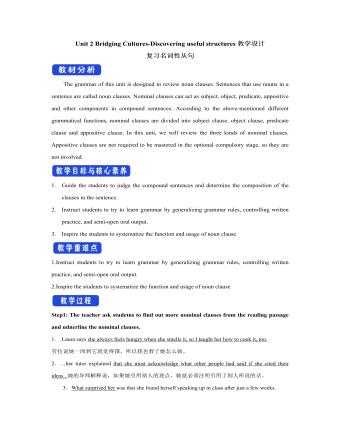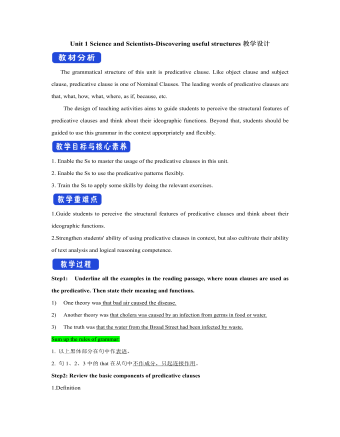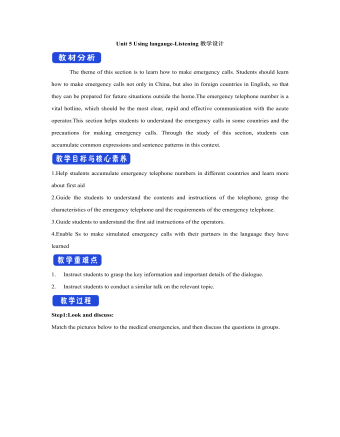新人教版高中英语选修2Unit 5 First Aid-Discovering useful structures教学设计
-
- 页数:10页
- 字数:约 11480 字
- 大小:179.00KB
- 格式:.doc
- 版本:Office2016及以上版本
- 作者:Vincent演示
Unit 5 First Aid-Discovering useful structures教学设计
复习动词ing形式
TheGrammatic Function of the Verb-ing Form in Sentences: Gerunds are used assubject, object, predicate and attributive in sentences, and the presentparticiple is used as adverbial, object complement and attributive insentences.

1. Lead students to rewritethe sentence with the -ing form and summarize the different structures in thesentence
2. Lead students to summarizethe grammatical function of the "ing" form of the verb and understandits expressive effect.
3. Guide students to learngrammar from self-induction of grammar rules to flexible use of grammar pointsand language output.
4. Guide students tounderstand the difference between –ing form of verbs and the gerund forms.
1. Guide students to learn grammar from self-induction of grammar rules toflexible use of grammar points and language output.
2. Guide students to understand the difference between –ing form of verbs andthe gerund forms.
Step1: The teacher asks studwents to find out allthe sentences in this unit containing –ing forms and then sum up their fuctions.
1.It also helps control your body temperature,prevents your body from losing toomuch water...
2.As you can imagine,gettingburnt can lead to very serious injuries.
3.The first and most important step in the treatment of burns is givingfirst aid.
4.Burns are divided into three types,depending on the depth of skin damage.
5.Examples include burns caused by electric shocks,burning clothes,or petrol fires.
6.Remove any clothes using scissors if necessary,unless you see the fabric sticking to the burnt skin.
7.Applying oil to the injured areas is a bad idea,as it will keep the heat in the wounds andmay cause infection.
8.Place burns under cool running water,especially within the first ten minutes.
语法功能:
1.句1中的v.ing形式在句中作宾语。
2.句2、7中的v.ing形式在句中作主语。
3.句3中的v.ing形式在句中作表语。
4.句4、6中v.ing形式在句中作状语。
5.句5、8中v.ing形式在句中作定语。
6.句6中v.ing形式在句中作宾补。
Step2: The teacherinstructs Ss to review the basic knowledge about –ing forms:
动词ing形式在句中的语法作用:动名词在句中作主语、宾语、表语和定语,现在分词在句中作状语、宾语补足语和定语。
一、动词ing形式(动名词)作主语
1.动词ing形式作主语时,往往表示经常性、习惯性的动作,通常置于句首。
Reading aloud is a good way to learn a language.
大声朗读是学习语言的一种好方法。
Wasting a persons time is the same as killing him for hisproperty.
浪费别人的时间无异于谋财害命。
[点津] (1)不定式作主语表示具体的或一次性的动作。
To lie to her is wrong.对她撒谎不对。
(2)动名词作主语时,谓语动词用单数。
Climbing mountains is really difficult for the old.对于老人来说爬山确实困难。
2.形式主语it代替动词ing形式作主语。
此类句式常见的有:
Its a waste of time doing sth. 做某事是浪费时间
Its useless/worthwhile doingsth. 做某事没用/是值得的
Its no good/use/fun doingsth. 做某事没用/没意思
It is no use waiting for other people to make decisions for you.
等别人替你做决定是没有用的。
It is a waste of time persuading such a person to join us.
劝说这种人加入我们是浪费时间。
3.当句型“There is no...”表示“不允许、禁止某种行为的发生或存在”时,需用动词ing形式作主语。
There is no denying that the environment is from bad to worse.
不能否认,环境状况正在逐步恶化。
There is no joking about such matters.这种事开不得玩笑。
Playing with fire is dangerous.玩火危险。
Be careful!To play with fire willbe dangerous.小心点!玩火会带来危险。
Swimming is a good sport in summer.夏天游泳是一项好的体育活动。
Its no use complaining without taking action.只抱怨不行动是没用的。
二、动词ing形式(动名词)作宾语
1.作动词的宾语
常接动词ing形式作宾语的动词有:
avoid、miss、postpone
advise/suggest、finish、practice
enjoy、imagine、cant help
admit、deny、envy
escape、risk、excuse
stand、keep、mind
Would you mind opening the window?你介意打开窗子吗?
He tried to avoid answering my questions.他试图对我的问题避而不答。
2.作动词短语的宾语
常见的跟动词ing形式作宾语的动词短语有:insist on、object to、be good at、be fond of、lead to、put off、give up、look forward to、feel like、devote to、get/be used to、pay attention to、be worth等。
He insisted on doing it in his own way.他坚持要按照自己的方法做。
3.在有些动词的后面,如:start、begin、continue等既可接动名词也可接不定式作宾语,两者意义区别不大。
They continued working/to work as if nothing had happened.
他们继续工作,似乎什么也没发生过。
4.在love、hate、prefer、like等动词后接动词ing形式作宾语指经常性的动作,用不定式作宾语指具体的动作。
He preferred staying in the house when it rained.
下雨时他宁愿待在家里。(用动词ing形式作宾语,指每逢天下雨都待在家里。)
I prefer to stay at home this afternoon.
今天下午我宁愿留在家里。(用动词不定式作宾语,表示今天下午留在家里这一具体的动作。)
5.有些动词(短语)后跟不定式和动词ing形式作宾语均可,但含义不同。常见的有:
动词
宾语的形式
意义
forget
to do
忘记做……
doing
忘记做过……
remember
to do
记着要去做……
doing
记得做过……
regret
to do
遗憾/抱歉要做……
doing
后悔做了……
try
to do
尽力做……
doing
尝试做……
mean
to do
打算做……
doing
意味着……
go on
to do
接着做(另外一件事)
doing
接着做(同一件事)
stop
to do
停下来去做……
doing
停止做……
Please remember to give my best regards to your family.请记着代我向你的家人问好。
I still remember visiting the museum for the first time.我仍记得第一次参观博物馆的情景。
6.下列动词可接动词ing形式的主动形式表示被动意义,相当于不定式的被动形式。
need/want/require/deserve doing=need/want/require/deserve to be done
The bike needs repairing/to be repaired.这辆自行车需要修一下。
I remember to mail the letter but forget to buy the stamp.我记得要去寄信可忘了买邮票了。
Missing the train means waiting for another hour.误了这班火车就意味着再等一个小时。
Its quite hot today. Do you feel like going for a swim?今天很热。你愿意去游泳吗?
三、动词ing形式作表语
作表语的动词ing形式包括现在分词和动名词。
1.现在分词作表语,往往具有形容词的性质,说明主语的性质、特征等。作表语的现在分词,许多是由能够表示人们某种感情或情绪的动词变化而来的。常见的有moving、interesting、encouraging、exciting、inspiring、boring、surprising、puzzling、amusing、astonishing ...这类分词有“令人……的”的含义,常修饰物。
The argument is very convincing.这个论点很令人信服。
Your speech is very interesting and encouraging.你的演讲很有趣而且很鼓舞人。
2.动名词作表语多表示抽象性的或习惯性的动作,一般说明主语的内容。
Her job is keeping the lecture hall as clean as possible.=Keeping the lecture hall as clean as possible is her job.她的工作是尽量使报告厅保持干净。
His job is painting walls.他的工作是粉刷墙。
His job is to paint the wall.他的工作是粉刷这面墙。
四、动词ing形式作定语
动名词和现在分词都可以作定语,但有所区别。
1.动名词作定语表示被修饰词的某种性能或用途,相当于for引导的介词短语。
No one is allowed to speak aloud in the reading room.阅览室里不准大声说话。
2.现在分词作定语时,它和被修饰词之间有逻辑上的主动关系,表示所修饰词进行的动作,相当于一个定语从句。
The boy playing football on the playground is my younger brother.
=The boy that/who is playingfootball on the playground is my younger brother.
在操场上踢足球的那个男孩是我的弟弟。
[点津] 现在分词、过去分词和不定式作定语的一般区别:现在分词表示正在进行或习惯性的动作;过去分词表示被动或完成意义;不定式表示动作尚未发生。
You should adapt to the changing situation.你应该适应不断变化的形势。
The ground is covered with fallen leaves.地上满是落叶。
Our school went on an organized trip last week.
我们学校上周进行了一次有组织的旅行。
I cant go with you, for I have a lot of work to do.
我不能和你一起去,因为我有许多工作要做。
Theres a note pinned to the door saying when the shop will openagain.
门上别着一张便条,上面写着商店什么时候再开门。
五、动词ing形式(现在分词)作宾语补足语
动词ing形式作宾语补足语时,表示正在进行的动作或经常存在的状态。动词ing形式常作以下动词的宾语补足语。
1.表示感觉和心理状态的感官动词(短语)(常见的有see、hear、feel、smell、find、notice、observe、look at、listen to等)+sb.+doing sth.(作宾语补足语)。
I felt somebody standing behind me.我感觉有人站在我后面。
I saw the little boy crying there.我看到小男孩在那儿哭。
2.表示指使意义的使役动词(常见的有have、let、keep、get、leave等)+sb./sth.+doing sth.(作宾语补足语)。
We kept the fire burning all night long.我们让火整夜燃烧着。
I wont have you running about in the room.我不允许你在房间里跑来跑去。
[点津] 使役动词接现在分词作宾语补足语表示“让……一直做某事”。接不带to的不定式作宾语补足语表示“让某人做某事”;接过去分词作宾语补足语,表示“主语请某人做某事,使完成某事或主语遭遇某事”。
They use computers to keep the traffic running smoothly.他们用电脑使交通畅通。
The old couple often take a walk after supper in the park withtheir pet dog following them.
那对老夫妇晚饭后经常带着他们的宠物狗在公园散步。
He had the walls painted this morning.他今天早上让人粉刷了墙。
Toms mother made him paint the house.汤姆的母亲让他油漆房子。
Be careful, or youll have your hands hurt.当心,否则会弄伤手的。
3.用于with复合结构中。
I couldnt do my homework with the noise going on.由于噪音不断,我没法做家庭作业。
With so many people looking at her, she felt nervous.这么多人看着她,她感到紧张。
I suddenly felt myself being hit by a heavy fist.我突然感到自己被重重地打了一拳。
He wants to have his eyes examined tomorrow.他明天想去检查眼睛。
We shouldnt keep our lights burning in the day.我们白天不应该开着灯。
With all fans singing together,he felt soproud.所有的粉丝一起歌唱,他感到如此的骄傲。
六、动词ing形式(现在分词)作状语的用法
现在分词(短语)在句中作状语来修饰谓语动词或整个句子,表示动作发生的时间、原因、条件、结果、方式、让步或伴随状况。
1.作时间状语(相当于一个时间状语从句)
Walking in the park, she saw an old friend.=When/While (she was) walking in the park, she saw an old friend.当她在公园里散步时,她看到了她的一个老朋友。
[点津] 当表示正在进行的动作时,可直接在分词前面加上when/while,此时也可理解为状语从句的省略。
2.作原因状语(一般可转换成由as或because引导的原因状语从句)
Being ill, he couldnt go to school.=As he wasill, he couldnt go to school.
因为生病了,他无法去上学。
3.作条件状语(一般放在句首,其前可以加if、unless等连词)。
Working hard, youll make great progress.=If you work hard, youll make great progress.
如果你努力工作,你将取得很大进步。
4.作结果状语
现在分词作结果状语时,通常放在句末,中间用逗号隔开,表示一种顺其自然、意料之中的结果。
The hospital has recently obtained new medical equipment, allowingmore patients to be treated.
这家医院最近得到一批新的医疗设备,这使更多的病人能得到治疗。
[点津] 现在分词作结果状语,是随着谓语动词的发生而产生的自然结果,其逻辑主语往往是前面整个句子所描述的情况,前面有时候可以加thus。而不定式作结果状语时常表示出乎意料的结果,有时前面可以加only。试比较:
He was caught in the rain, thus making himself catch a cold.被雨淋后他感冒了。
I hurried to school, only to find it was Sunday.我匆忙赶到学校,结果发现是星期天。
5.作让步、方式和伴随状语
现在分词作让步、方式和伴随状语时,说明动作发生的背景和情况。作伴随状语时,表示分词的动作和主句的动作同时发生,此时它可转换成并列句。
Mary sat by the window of the classroom, reading a book.=Mary sat by the window of the classroom and was reading a book.
玛丽坐在教室的窗边读一本书。
[点津] 为强调动词ing形式表达的意义,可在其前加上各种连词。例如,加上when、while,强调与谓语动词同时发生;加上before、after,强调动作先后发生;加上thus,强调结果;加上(al)though,强调让步等。
Though knowing allthis, they made me pay for the damage.
尽管他们了解这一切,但还是让我赔偿损失。
There is no greaterpleasure than lying on my back in the middle of the grassland, staring at thenight sky。没有什么比躺在草地中央,望着夜空更快乐的事了。
Being poor, he cantafford a computer.因为穷,他买不起电脑。
Newlybuilt woodencottages line the street, turning the old town into a dreamland.
新建的木屋沿着街道排列,把老城区变成了一个梦幻之地。
七、动词ing形式的时态和语态
语态
时态
主动语态
被动语态
一般式
doing
being done
完成式
having done
having been done
1.现在分词的时态
当现在分词的动作与谓语动词的动作同时发生时,用分词的一般式;当现在分词的动作先发生,而谓语动词的动作后发生时,用分词的完成式。
Walking in the street, I met an old friend of mine.
我正在大街上行走时,遇到了一位老朋友。(walking和谓语动词met同时发生)
Having finished the letter, he went to post it.
他写完信后就把它寄了出去。(havingfinished是先发生的,went是后发生的)
2.现在分词的语态
使用现在分词的主动式还是被动式,这主要取决于现在分词和句子主语之间的关系。句子的主语就是分词的逻辑主语。
Having been shown around the factory, they were very happy.(现在分词的被动式)
被领着参观了工厂后,他们很高兴。
Having finished his homework, he went to bed.(现在分词的主动式)
完成了作业后,他上床睡觉。
Seeing nobody at home, he decided to leave them a note.
看到没人在家,他决定给他们留个便条。
Having been told for several times, he still couldnt understandthe rules.虽然被告诉了好几次,他还是不明白规则。
Having received his reply, she rang him up.收到他的回信后,她给他打了电话。
Being talked to, you should look into the eyes of the person.和别人说话时,你应该看着对方的眼睛。
Having been asked to work overtime that evening, I missed awonderful film.由于那天晚上被要求加班,我错过了一场精彩的电影。
八、动词ing形式的否定形式及动词ing形式的复合结构
1.动词ing形式的否定形式通常是在其前加not,带有逻辑主语时 not应放在逻辑主语和动词ing形式之间。
You have no excuse for not going.你没有理由不去。
He was punished for not having finished his homework.他因未完成作业而受到惩罚。
2.动词ing形式复合结构由物主代词或人称代词宾格、名词所有格或普通格加动词ing,即“sb./sb.s+doing”构成。动词ing形式的复合结构实际上是给动词ing形式加了一个逻辑主语。动词ing形式的复合结构有四种形式:
①形容词性物主代词+动词ing
②名词所有格+动词ing
③代词宾格+动词ing
④名词+动词ing
Her coming to help encouraged all of us.她来帮忙鼓舞了我们所有人。
您可能喜欢的文档
查看更多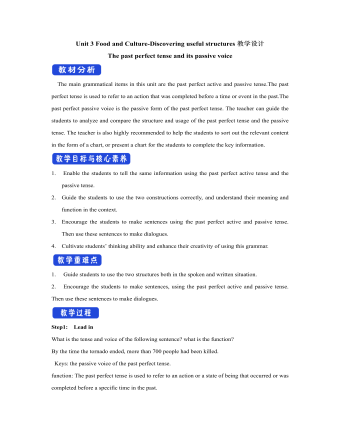
新人教版高中英语选修2Unit 3 Food and Culture-Discovering useful structures教学设计
- 页数:5页
- |大小:152.00KB
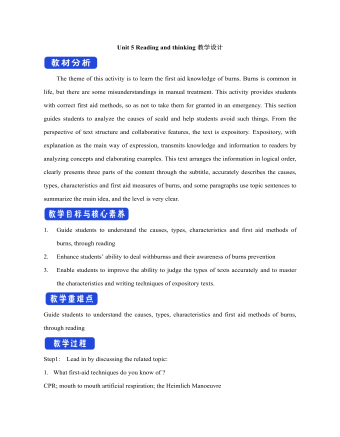
新人教版高中英语选修2Unit 5 Reading and thinking教学设计
- 页数:4页
- |大小:129.50KB
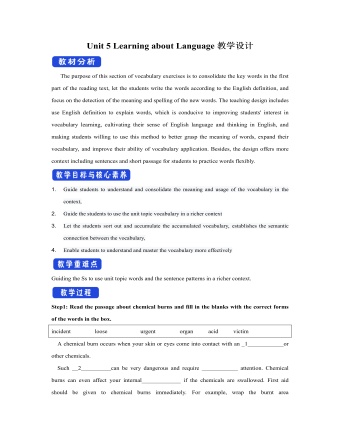
新人教版高中英语选修2Unit 5 Learning about Language教学设计
- 页数:4页
- |大小:138.00KB
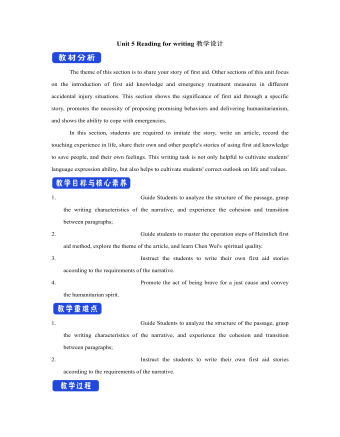
新人教版高中英语选修2Unit 5 Reading for writing教学设计
- 页数:4页
- |大小:317.50KB
热门课件教案
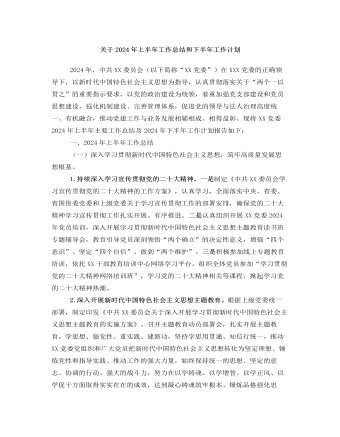
关于2024年上半年工作总结和下半年工作计划
- 页数:5页
- |大小:29.72KB
- 课件教案
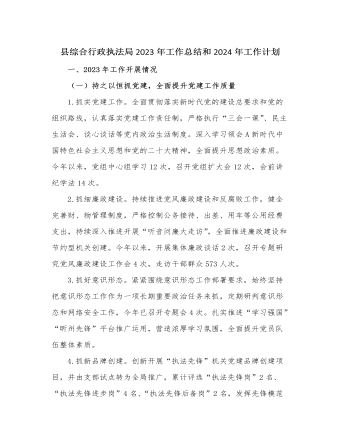
县综合行政执法局2023年工作总结和2024年工作计划
- 页数:8页
- |大小:28.37KB
- 课件教案

精选高中生期末评语
- 页数:42页
- |大小:7M
- 课件教案
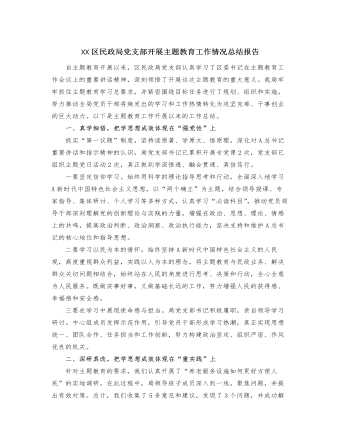
XX区民政局党支部开展主题教育工作情况总结报告
- 页数:3页
- |大小:24.47KB
- 课件教案
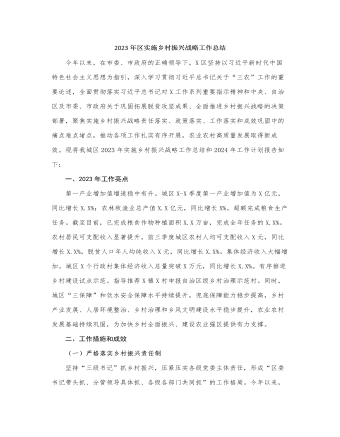
2023年区实施乡村振兴战略工作总结
- 页数:6页
- |大小:27.90KB
- 课件教案
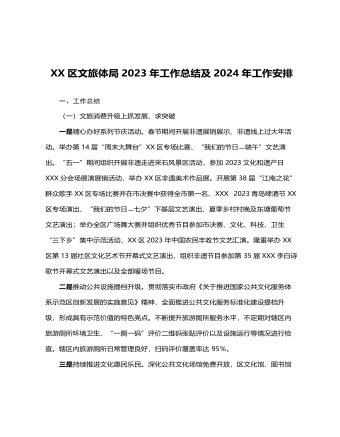
XX区文旅体局2023年工作总结 及2024年工作安排
- 页数:8页
- |大小:32.41KB
- 课件教案
今日更新

精选高中生期末评语
- 页数:42页
- |大小:7M
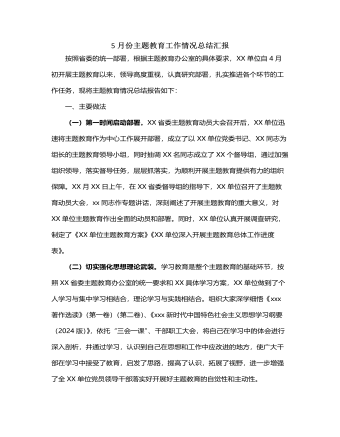
5月份主题教育工作情况总结汇报
- 页数:3页
- |大小:136.87KB

××县招商局2024年上半年工作总结
- 页数:12页
- |大小:142.54KB
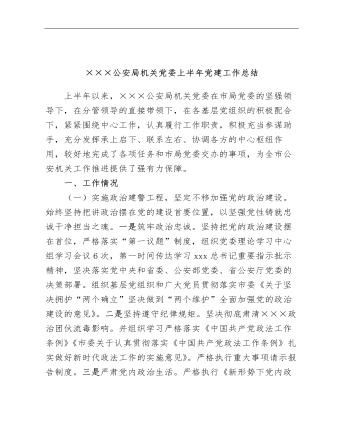
×××公安局机关党委上半年党建工作总结
- 页数:7页
- |大小:186.25KB

《2019—2024年全国党政领导班子建设规划纲要》实施情况的工作总结3800字
- 页数:6页
- |大小:29.16KB
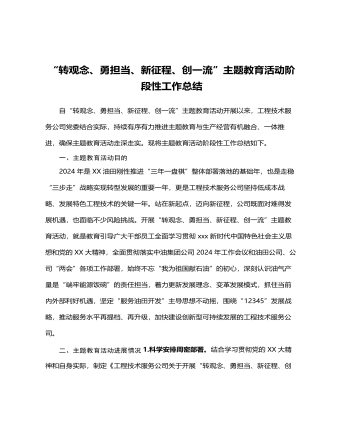
“转观念、勇担当、新征程、创一流”主题教育活动阶段性工作总结
- 页数:3页
- |大小:22.76KB
